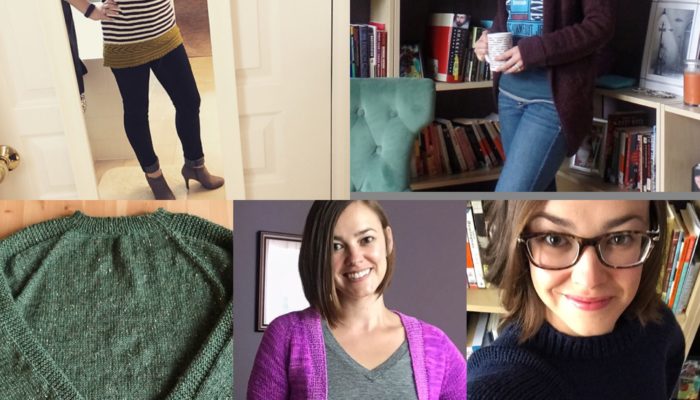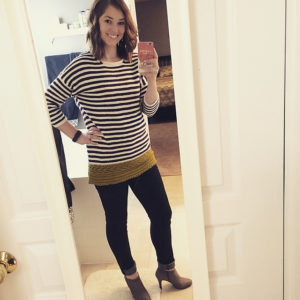
My Journey to #SlowFashion
One year ago, I was knitting my very first adult-sized sweater. It was a goal of mine for 2016 to make a sweater for myself for no other reason than I could, and I would be proud to wear something I made with my own two hands.

My first sweater
Since then, I’ve made about a million baby sweaters, a total of four sweaters for myself, and one for Tim. There’s just something about sweater knitting for me that is unlike any other make. I don’t generally do any complicated lace or cables, so the endless rows of knitting are soothing and easy, and the end result is always fabulous. I have yet to make a sweater I don’t like.
But something else happened when I started sweater knitting. I started to pay attention to other people who knit sweaters, and why they knit sweaters. Then, I started to see that these sweater-knitters not only knit clothes for themselves, but sewed them, too. Conveniently, my mom had bought me a serger for Christmas, and so I started trying that out, too. I made myself a few dresses, and I made Emily about a million summer clothes. Not everything worked out, and some of it fell apart after the first wash, but I learned a lot.
At first, making my own clothes was an exercise in pride. I wanted to be able to say that I made my clothes, and I was excited to have pieces that were unique. Eventually, though, my journey into the world of slow fashion became much more than that. It became a new kind of activism for me, both in ethical fashion, and in loving my body.
First, loving my body. Before Emily was born, I was skinny. Super skinny. And I didn’t have to work very hard at it. Everyone promised me I’d “bounce back” right away after the baby was born, but a c-section, some major anxiety, and a year of insomnia later, I started to realize I would probably never get back to the weight I was before I got pregnant. I bought myself some new clothes, but they were cheap and poorly made because I felt guilty about having to go through two entirely new wardrobes in less than two years between my maternity clothes and my post-baby clothes. I was never happy in anything I wore, both because the new clothes I had weren’t very nice, and because I had to cultivate an entirely new personal style because the tight t-shirts and cardigans I used to wear now showed by squishier belly. It was frustrating.
It was also frustrating that I didn’t want to ever go clothes shopping – hence the cheap new wardrobe built almost entirely from Amazon and Target – for several reasons. First, most of my friends have babies of their own and taking babies clothes shopping is the absolute worst. I didn’t want to go alone, because that is soul-crushing, but I didn’t really want to go with friends, either, because it’s even worse when you try on a million things in the dressing room and don’t want to show anyone because you’re not happy with the way you look.
One night, while Tim was out with the guys and Emily was sleeping, I had a few glasses of wine and decided I was going to take my own measurements once and for all. I figured this would help me order clothes online that would reliably fit me, and would help me choose sizes of patterns to make myself. So I did it, and it changed my world. I have not bought or made a single item of clothing since that does not fit me the way I expect it to which, as you might imagine, is really empowering. It truly taught me that clothes should be made to fit me, not the other way around.
But an incredible by-product of all of this is that I naturally became more conscious of the clothing choices I was making. If I was going to spend time making an item to wear, it had to be perfect, and it had to be something that my closet was lacking. If I was going to buy something, I was going to buy nice clothes that fit well and would last. I had to be willing to spend a little more money, sure, but it would be worth it in the long run.
As I found these brands of clothes that I liked, and as I did more research, I was drawn towards brands that were working to make a difference. The truth is, any way you slice it, someone makes your clothes. Is that person paid a living wage? Do they work in acceptable conditions? If you don’t know, and if you paid less than $20 for that t-shirt, the answer is probably not. Add to the human cost of clothing the fact that fast fashion is creating an environmental crisis, and that $10 cardigan you picked up from Walmart costs a whole heck of a lot more in the long run.
I always kind of knew this, but doing the research really made it hit home with me. And, once we elected a climate change denier to the White House, I decided I had to do my part to make a difference.
I know I said no New Year’s resolutions for me this year, but I do have a goal: I’m not buying any clothing that isn’t either second-hand or ethically made, and I’m going to make as much as possible of what I need or want myself. And I’m going to try to document this journey as much as I can on this blog so maybe I can inspire a few of you to make just a few changes to your wardrobe this year, too.
Itching to get started? Try reading this quick e-book from The Root Collective.
You can also try buying second-hand, which is a great and economical way to reduce the impact of fast fashion, from sites like threadUP, or you can visit your local thrift store.
You can also follow these ethical fashion companies on Instagram to see just how beautiful ethical fashion can be: